There is an endless list of scenarios in which you would need to retreat into a bunker. The problem is that constructing one can seem too daunting for all but the most serious preppers and survivalists.
The truth is that building a bunker is only as expensive and complex as you make it, and there are many different styles and construction methods that you can use to construct your bunker.
Before You Start Digging
Every jurisdiction in most countries has permitting processes that you need to go through before starting construction on anything in your home, bunkers included.
So always check and ensure that you follow all the rules and pull all of the appropriate permits before you begin construction.
Related: When Did Independence Become Illegal?
A Few Things to Consider
Any bunker that you build needs to support life during whichever event has driven you to hide inside of it.
Since you will not be leaving the bunker for as long as the threat is outside, you will need to have enough food, water, medical supplies, tools, equipment, communication gear, etc, to ride out whatever is going on beyond the doors.
You will also have to take special care and consideration in providing adequate climate control and ventilation. We are all dead within about three minutes of no oxygen, so you need to make sure that there is enough fresh air flowing through the shelter. It is advisable also to install filters to remove any contaminants from the air.
These are examples of ten bunkers that you can build on your property:
Panic Room
A panic room is not technically a ‘bunker,’ but it serves the same purpose of hiding you from a threat outside.
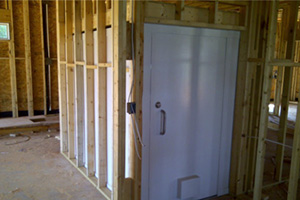
Panic rooms are built within your home and are usually a small room that you can conceal from view. To make a panic room, you need to find a space within your home that you want to turn into a panic room, then reinforce the walls, ceiling and floor so that no one could break through them.
You could use concrete, metal or thick solid wood.
The important thing to remember is to make sure that area of your home can support the additional weight. You will also need a heavily reinforced hidden doorway.
Related: How To Make An Invisible Shelter Against Looters
Crawl Space/Basement/Root Cellar
Staying with the theme of building bunkers within the walls of your home, turning a basement, crawlspace or root cellar into a bunker is also a viable option to look at.
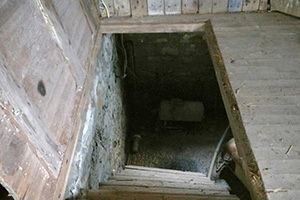
A good thing about concealing a bunker beneath the main floor of your home is that it gives you many options for hiding the entrances and exits.
For example, it would be very simple to conceal a doorway to your bunker under a rug or piece of furniture.
As with building a panic room, you will need to reinforce the bunker’s ceiling so that no one can gain access by breaking their way through your floor.
Bury a Sea Container
There has been much debate over whether or not burying a sea container is a good way to build a bunker.
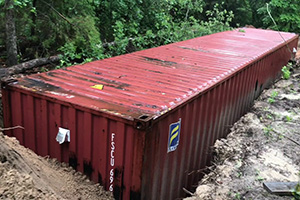
If you can engineer ways around the weight of the dirt buckling the sides, placing a sea container underground can be a viable option for you to look at.
Don’t simply dig a hole, drop in the container, cover with dirt; do some research and do it properly.
Steel Culvert
To counteract the issues using a sea container poses, we can also use a section of steel culvert tube that is large enough to construct a livable space within it.
In addition, since culverts are designed to be buried under the ground, they are a good option for underground bunkers.
Related: Where to Go When You Don’t Have a Nuclear Bunker
Above Ground Bunker
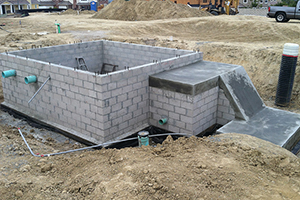 There are no rules that say your bunker must be underground. As long as you take steps to conceal the bunker’s location and build the walls, ceiling, floor, and entrances and exits so that they would be exceptionally difficult to break through, you can construct an above-ground bunker.
There are no rules that say your bunker must be underground. As long as you take steps to conceal the bunker’s location and build the walls, ceiling, floor, and entrances and exits so that they would be exceptionally difficult to break through, you can construct an above-ground bunker.
Such a bunker should be kept away from prying eyes through the use of camouflage. You can build an above-ground bunker out of concrete, cinderblocks or bricks, or metal, to name a few.
Pre-Fabricated Bunkers
You can purchase a ready-built bunker that only requires a hole to place it in.
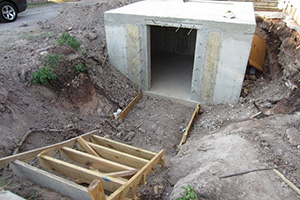
These bunkers are a great option for those who do not have the time or the technical expertise to build a bunker from scratch.
There are various sizes and styles to choose from, and the sky is the limit on how much you can spend purchasing one of these units.
Luxury Bunkers
Everything in life has a luxury brand, and bunkers are no different.
So if you want to survive the apocalypse in style, then there are companies you can call who will build you a bunker that is probably nicer and more expensive than the home you live in now.
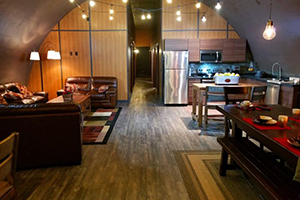
The goal of luxury bunkers is to provide you with a place to survive the end of days without sacrificing the high-end finishings, comfortable beds, and gourmet kitchen.
You may even want to move into the bunker full-time!
Dig a Bunker into a Hill
If you have a sizeable hill on your property, you may want to consider digging a bunker into the side of it.
Related: Emergency Shelters When You Are On The Move
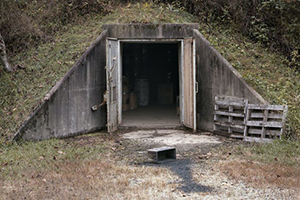
This is not a DIY job, though; since you are effectively excavating the interior of a hillside, you will need to use the services of professionals to do your excavating.
In addition, the actual construction of the bunker may also be problematic and require the services of a professional contractor and engineer.
Concrete Underground Bunker
Building a simple underground concrete bunker is almost as simple as digging a large hole, pouring a reinforced concrete floor, walls, and roof, then covering it with a couple of feet of dirt.
Remember to include both entrances and exits and a robust ventilation system.
Include a Bunker in a New Home Build
If you are building a new home on your property, it makes much sense to include a bunker in the plans. This way, there are fewer issues with obtaining permits, the construction crew is already there, and some of the costs of the bunker can be less since it is included in the price of your home.
You also have greater flexibility over exactly how the layout will look and how you will access the bunker and exit if you need to flee.
Concluding Thoughts
The likely hood that you will have to hide in your bunker is small but not zero. Even events like civil unrest and rioting may be bestridden out by slipping away to your bunker to wait until it is over.
So regardless of the reason you find for building a bunker on your property, there is a bunker out there that will suit your needs and budget.
You may also like:
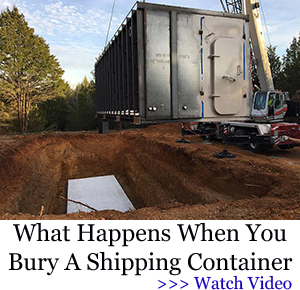 What Foods Can You Bury Underground For Winter?
What Foods Can You Bury Underground For Winter?
The $200 A Pound (Dried) Common Mushroom That Could Be Growing In Your Area (Video)
How To Build A Survival Debris Hut

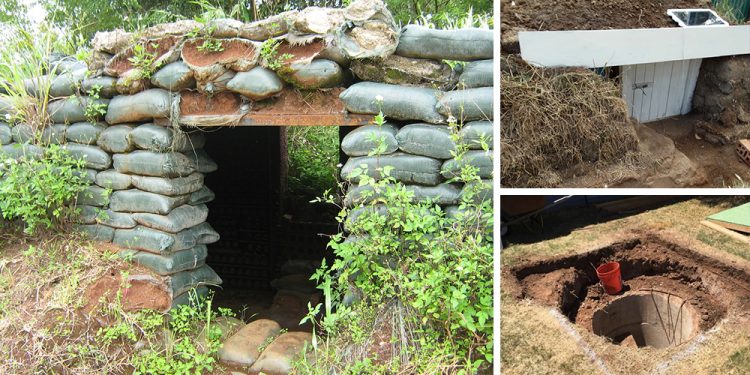













a cave also makes a great bunker that is what I use on my place , you only need to have a very strong door on it and a air supply and other things to live in it for a long time .
I have double deadbolts on a security door to our bedroom. Bars on windows. Hidden entry to under the house. Bed propped up with cans of beans. An old shotgun and bear spray. Cheap and safe for temporary home invasion and probably longer. Will work in a city location. So far, so good.
shipping containers were made to be stacked. the pressure is at the corners where it is stacked. If u bury a shipping container the dirt will eventually cave in the walls unless u build a concrete wall between the container and the earth. if u build the concrete retaining wall why do u need the container?….perhaps for the doors only.
also used containers may have held dangerous chemicals….they would have to be cleaned before humans can occupy them. they also need insulation and water proofing….consider plastic septic tanks. I have looked at one that is shipped in two halves. U easily join the upper and lower with clamps and install the plumbing…….or have a pro do it…..I am thinking of getting one of these and using both the top and bottom…..as sides and roof….place on a concrete brlck wall to give u height and a flat floor…..u would need to build some kind of support on the outside so the dirt does not cave in the top……altho they are built to be buried….u get an extension for the entrance cover…..say 3 ft or more and can enter the tank via the top….then close the cover….just an idea…I think a good size tank is less than 1000 usd…..then there is the cost of the concrete blocks and concrete for the flat floor and what ever else u are going to add….steel door…..steel air pipes in and out ( don’t use plastic)…..just an idea…atlas bunkers makes a bunch of prefab bunkers……ranging in size and price from $10,000 to $100,000 and more….there are also gov’t pamphlets written by Civil defense that give u tips on DIY shelters. You can incorporate some of their ideas and make the plans bigger or smaller based on your need/ budget…..look on line for the plans as i dont think civil defense prints them any more….
Amazing comment! Yes, whatever happened to civil defense programs here in the US? For the life of me, I just can’t understand why More has not been done especially in the Central, Southern and Mid West states to assist people in being able to have ready shelters available to them in or near their homes, businesses and schools so that they can evacuate to safely in a weather emergency. I’m not saying fund it all, but help make it easy to do and gat least make it tax deductible!
breaks
the late departed Professor used 42 school buses as concrete forms to build the world’s largest private underground bunker – Ark II >>>> https://www.prepperfortress.com/ark-two-underground-bunker-largest-private-doomsday-shelter-on-earth/
if you did not here the full story he did it large enough to save all the children in his community
interesting story but today local or state would probably lock him up . and todays school bus are Significantly stronger
I have a bunker that was built into the hillside either as a storm cellar or root cellar. Either way, it has a tendency to hold water which is not what I would want in a storm cellar or root cellar. Can anyone tell me how I can get the water to drain away from this building?
My brother made a septic tank using a large blue plastic barrel, heavy duty, not flimsy. He used black flex piping to connect toilet to tank. Has worked great for 20 years! Barrel & piping cost under $80, only took him 1 day & he did work himself. Another tip….run sink & shower water pipes directly outside into a drain ditch. Water keeps ground moist for any plants, crops or worms. We grow ours about 5 to 8 feet from drain ditch.
Two possibilities: First, and I believe preferable, run a waste drain with suitable water traps to block things getting in, depending on your site may be difficult. That said; if your site doesn’t permit drainage you are a bit screwed for sanitary considerations also. Second possibility is to install all needed plumbing to have a sump pump and (if intending more than 3 days inside) also some way to remove bodily waste. Contact a certified local jobber to survey the task, might not be horrible.
Cygnet Brown you need to find out if it’s rain water seeping in or ground water seeping in.
If your “Bunker” is in the ground water lever your out of luck. Water wins eventually.
If it’s rain water a uphill ditch in a U to redirect water around your bunker may help. A French drain is better again GIVE WATER a Easy Path around your bunker. Don’t go cheap on the French drain dig deep and wide with plenty of excellent drain materials like perforated leech line pipes and gravel.
You may need to demolish it and redesign it so it does not flood. Or.build in a better location
Maybe a “French-Drain” on the upside of your cellar would help to solve this issue for you. Another idea… You could have one of those companies that do basement and crawlspace water-proofing could come out and give you an estimate on what would be needed to make your cellar viable again. Good luck with this!
there is not enough info to answer this. we don’t know your land, the lay, the type of soil, the materials, etc. possibly digging a drain would work, but hard to say.
bunkers without purpose are a waste of time and $$ Most of your bunker will not stand an attack or provide needful shelter to hide out
It doubles as a root cellar.
It may as well be a root cellar, red. If someone is actually thinking of creating a purpose-built underground bunker that they plan to live in for an extended period of time they have to take many things into consideration. Water drainage. Heating and cooling. Wood, propane or natural gas? Cooking in the bunker. Masking the smell of cooking. Or are you going to live only on food bars? Filtered air into and out of the bunker. Concealing the air inlet and outlet. Electrical power. Do you need it? If so, gas or diesel? How do you mask the sound of the engine? Enough stored food and water to last for at LEAST a month. Preferably six. So you need a BIG bunker. Sanitation. Urinating and defecating in the bunker unless you want to sneak out at night and do it then. Do you want a periscope in the bunker? The door has to be heavy enough so that it can’t be easily breached. The door also has to be concealed and camouflaged well enough so that it’s almost impossible to find. If you decide to leave the bunker for a short time to go forage for fruit or berries you’ll leave a pathway or trail in the terrain that will lead directly back to the door of your bunker. So once you enter your bunker you can’t leave it again until you deem it safe to do so. You’re stuck. It’ll be worse than the lockdown we’re stuck in now. At he very least an emergency radio so you have some kind of an idea when it’s safe to come out again. How do you keep yourself occupied? Cards? Board games? Reading? And then you need an emergency exit in case the local warlord takes an interest in your bunker. And then THAT door has to be even stronger and more well concealed than your main entrance. And then you need a secondary location as well-stocked and fortified as your primary location. All in all a bunker doesn’t sound like such a good idea to me. If you’re serious about it, and there are still some available, you may as well buy a decommissioned missile silo. And then it’s a fixer upper. But even then you’d need people around the clock to guard the entrance. And a lot of money to buy one. May as well build a house at the bottom of the ocean. 😉 These are all the things that I could think of that you’d need to take into account. I’ve probably missed a few.
Root cellar with multiple rooms. Heating more than cooling, especially if we run into a nuclear winter. Remember how Inuit heat an igloo? One candle or small lamp will send the thermometer up to 56-65 F. Snow starts to melt on the inside and reflects heat back. We use insulation. It still needs to be vented to prevent CO2 poisoning. Septic, if you want to go with a higher cost/safety/convenience, add a composting toilet. It also needs to be vented and the smell might attracts raiders, animals and humans.
Post-Troubles, use a methane digester outhouse like they now do all over Asia. The effluent is considered safe for anything but root crops. With these you can use corn cobs or news paper. Remember to work the cobs, OK? If not, it’s like a thousand tiny knives in a very sensitive place.
Right now, we should all stock up on coffee and canned fruit. Brazil had blizzards, as did much of the coffee producing nations. Wide-spread flooding and late frosts damaged northern fruit production. Grain, same. Arizona gets most of her produce from Mexico and points south, so for the most part, we’re copacetic.
Electric can be solar, if you can hide the panels. Same with solar hot water. Solar is going to be a major raiding problem post-shtf. Any water used has to be disposed of in a sanitary way. Wash your hands, there’s bacteria in the water and it rots. A French drain works, a steel, rust proof barrel buried in the earth away from the shelter. If you can spare the power, even a small dehumidifier will prevent fungal problems and give distilled water.
The bunker is an ideal. If you have a few million to spare, you buy pre-fab, methane digester included. Or, like a bro down towards Sonoita, 8K for a huge culvert, 20 feet long. Paid that off, put in 2 upright 8 footers by the house to collect rainwater and as cover. Then bought another to bury and fix up. No one bothers to see what he’s doing anymore. He always has a new project. His wife jokes that the bunker is nicer than her house he built for her (and he is a master at building, wow!). He might add one more culvert but the price is shooting up.
Things you will need for a long stay are wastes disposal and a solar lamp for good health. Vitamins and mineral supplements, any meds, ect. niio
A fella I know who ran a landscape business outside of Dallas switched to installing/building underground tornado shelters. Prefabricated welded steel shelters are the most popular, it’s probably pretty easy to find a contractor doing this in tornado alley, which seems to have spread across the Southeastern states, too. Expensive. On DYI bunkers, having pulled a lot of permits over the years I wish anybody good luck getting a city or county permit on something built with sandbags, barrels, or culvert pipe.
So far as building an aboveground bunker out of brick, block, or stone, not a good idea, a motivated attacker could tear a masonry wall down with a 9 pound hammer about as fast as you flee out the back door.
There was an article here earlier this year called how to build a cheap bunker in your backyard, it had some good design ideas for underground bunkers using sandbags, except the roof designs were pretty inept.
Underground construction in my area means dynamiting a lot of rock, they price swimming pool construction by the amount of dynamite needed. So I’ll be remaining above ground, hopefully at least another 25 years.
We don’t get tornadoes. Winds off the valley of the sun blow them away (state capital, Phoenix, Maricopa county 🙂
LCC (God bless) had a thing where it showed how vulnerable masonry is. He couldn’t find raw adobe, but i know that’s ‘way better. But, nothing is perfect. Blocks usually range about 4 inches high in a wall, by 9 inches by 16. Even with a sharp pick it would take about 15 minutes to chip thru that. I have enough experience using a pick as first garden choice. niio
An Anglo army invaded San Antonio in the winter of 1835. The Mexican Army mounted their defense in the city instead of in The Alamo and the fighting became house to house. The walls of the adobe houses stood up well to the bullets and artillery available to the Texans, so they finally won the city by digging through the adobe walls with bayonets and entering each house to drive the Mexicans out. Probably why the Texans decided to make a stand in the Alamo instead the city when Santa Anna showed up a few months later with another army.
These days, if it requires a pick, I prefer not to do it, controls on the tractor fit my hand a lot better.
Good, interesting post, thank you!
Yeah, the Alamo is rock and adobe. Apaches would wet rawhide string and dampen the raw adobe. they could saw thru it. Indians plastered instead of blocks. Woven layers of ocotillo and mesquite twigs prevented that.
During the earthquake in 1985, homes built like that got cracks in the walls, but nothing worse. blocks and more modern buildings collapsed. Traditional plastered walls also tend to have small window with bars. Wood, but like Grampa said, they’re there to keep the honest people honest. niio
Yeah my hands won’t let me handle a pick anymore! Lol but I’m with you I wish Adobe was an option for me. But I’m in Ky, possible maybe? But then you have alot of people who are really nosy! We just had a tornado hit our town and several others in western Ky, that’s enough for me to build something that we can go to in case of another. Thanks for your info Judge! Have a nice day!
There are many good comments here…but in my humble opinion, Only a couple of these bunker ideas would work and only if I used stealth when building it.
Many knowledgeable people here on this site know some of what I am talking about below.
Every square mile on this planet is observed by satellites, the images you look at on the internet are low quality images…the government can see much better than what we can see, they can easily read your truck’s license plate from a satellite…and they can see individual heat signatures as well.
If you are bugging out…Stealth is absolutely required at your bug-out location, Only people that will be located there can be allowed there. No children under 16 prior to SHTF (loose lips sink ships). First build a couple small barns and a normal looking large barn (use these barns for your business purposes, yes you need to own an LLC business). Then move shelter things in at night, work (build underground shelter under the barn) by day. Depending on your shelter size, your barn needs to be much bigger. The more money you have, the more sophisticated the shelter can be). To much traffic to/from the location is not good. Project Planning each step and resolving the dependencies far in advance is required to quietly and quickly get it done.
And hope you don’t trigger an inquiry through certain LLC purchases, thus an agent could be sent to quietly check out your location. Unless you are breaking laws, they would do nothing, they would just know what you are doing and where you are doing it…and that is the big problem when the SHTF.
Sophistication: if money is not an object, three families, cross trained, with responsibilities for over 50 significant things that need to be addressed to survive for two years…undetected. It would take a five year project plan to secretly build an underground shelter with all the bells and whistles to house up to 15.
Good luck with that.
We already know that 90% of the population (over 300 million) would die the 1st year after an EMP. The effect would be worldwide (5 billion will die), and that can not be prevented, not even for Communist China…how are they going to feed 1.5 billion? They can’t. 200 million guerillas going after 1 million communists…communists are history.
What most don’t realize is 99% percent of preppers would probably not survive two years after an EMP, so if there are 1 million hard core preppers here, only about 10,000 well prepared very lucky preppers would survive for two years. There are just way-too-many-many unexpected things that will go wrong. Conflict avoidance has to be #1.
Bottom Line: It depends on how well your group is prepped and cross-trained before SHTF. That is how you improve your chances to be part of the 10,000 that survive an EMP, and hopefully create a new world. Only the strong, smart, well prepped and cross-trained will survive this unthinkable horrible crisis.
The Good News…an EMP is less likely to happen than an economic crisis. (However, that may have changed now that Afghanistan is home to ISIS again).
In an economic crisis scenario, cooperation with the local, state, and national government is highly suggested. They will have military night OPS, with massive firepower using Drones and Apaches to quickly come after resistance (that will be labeled terrorists to justify actions against Americans).
Passive resistance can be part of your nice cooperation, but very quietly done.
Many millions of people in the country will survive, but city folks will need a whole lot of luck just to get to the country.
Folks, The BEST solution to “possibly” stop all of this:
Elect the right people to get the many problems facing our country under control NOW!!! Time is running out…and I pray it is not already too late.
all its OK. peter
i understand wanting to have strong and safe but reading fema regs it seems they and other designs want a large entry door which is your main defense but imo you only need about a 3ft x 4 ft half door makes it a whole lot easer and cheaper without skimping and don’t forget with any safe room or shelter from storms let a relative or trusted friend in another area that you have it so authorities could be notified if you get trapped and cell or 2 way fails different than shtf but much more likely use
I really love all of these ideals, I am 67 years old I don’t have any land or own a home. I have for sometime now working on thing that myself and my husband, and our dog. The problem is there no way that we stay safe for what is going to happen, no matter what it is. However I want said thank you all again for all work putting this together.
Many thoughts, and lots of design. But how about *if* to survive from :
1. Nuclear blast.
2. Nuclear radiations.
3. What about the underground bunker *VENTILATION* & *SANITATION* while we in it?
I would like something for an old river cabin in case there is a tornado. Possibly a discarded heavy culvert or barrel?
The Container as a shelter. Consider covering the container sides and roof with Foam Crete This will strengthen the sides and top while maintaining the shape of the container. after cured, you can fill in the area and cover the roof without the buckling issues.